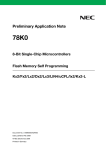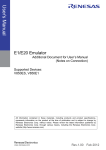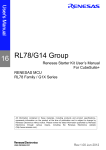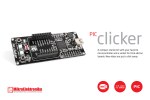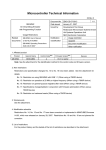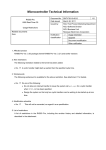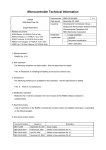Download 32-Bit Microcontrollers V850E/MA3 Usage Restrictions
Transcript
Microcomputer Technical Information CP(K), O 32-Bit Microcontrollers V850E/MA3 Document No. ZBG-CC-06-0031 Date issued September 1, 2006 Issued by 2nd Solution Group Multipurpose Microcomputer Systems Division 4th Systems Operations Unit NEC Electronics Corporation Usage Restrictions Related V850E/MA3 Hardware User’s Manual: documents U16397EJ V850E1 Architecture User’s Manual: Notification classification √ U14559EJ 1/2 Usage restriction Upgrade Document modification Other notification 1. Affected products V850E/MA3 • μPD703131A, μPD703131AY (ROM: 256 KB, RAM: 16 KB) • μPD703132A, μPD703132AY (ROM: 256 KB, RAM: 32 KB) • μPD703133A, μPD703133AY (ROM: 512 KB, RAM: 16 KB) • μPD703134A, μPD703134AY (ROM: 512 KB, RAM: 32 KB) • μPD703136A, μPD703136AY (ROM: 256 KB, RAM: 8 KB) • μPD70F3134A, μPD70F3134AY (flash memory: 512 KB, RAM: 32 KB) Remark For restrictions on non-A products (μPD703131, μPD703132, μPD703133, μPD703134, μPD70F3134 and μPD70F3134Y), individually contact an NEC Electronics sales representative or distributor. 2. New restriction This notification concerns the following restriction (No. 2). See the attachment for details. • No. 2 Restriction on flash memory programming Flash programming may end without causing an error even if unexpected data is written. 3. Action Firmware for flash memory versions will be modified so as to remove this restriction. 4. List of restrictions The restriction history and detailed information is described in the attachment. ZBG-CC-06-0031 5. Document revision history 32-Bit Microcontrollers V850E/MA3 Usage Restrictions Document Number Date Issued Description ZBG-CC-05-0011 January 17, 2005 Newly created. Addition of restriction No. 1. ZBG-CC-06-0031 September 1, 2006 Addition of restriction No. 2 2/2 ZBG-CC-06-0031 Attachment 1/5 List of Usage Restrictions in V850E/MA3 1. Product Version μPD703131A: Rank K μPD703131AY: Rank K μPD703132A: Rank K μPD703132AY: Rank K μPD703133A: Rank K μPD703133AY: Rank K μPD703134A: Rank K μPD703134AY: Rank K μPD703136A: Rank K μPD703136AY: Rank K μPD70F3134A: Ranks K, E μPD70F3134AY: Ranks K, E * The rank is indicated by the letter appearing as the 5th digit from the left in the lot number marked on each product. 2. Product History • μPD703131A, μPD703131AY, μPD703132A, μPD703132AY, μPD703133A, μPD703133AY, μPD703134A, μPD703134AY, μPD703136A, μPD703136AY No. Bugs Rank K 1 Restriction on sequence for turning on/off power Δ 2 Restriction on flash memory programming √ √: Bug does not occur, Δ: Bug will also apply in future, ×: Bug occurs • μPD70F3134A, μPD70F3134AY No. Bugs Rank K E 1 Restriction on sequence for turning on/off power Δ Δ 2 Restriction on flash memory programming × √ √: Bug does not occur, Δ: Bug will also apply in future, ×: Bug occurs ZBG-CC-06-0031 Attachment 2/5 3. Details of Usage Restrictions No. 1 Restriction on sequence for turning on/off power [Description] When turning on/off the power, if the voltage on the internal power supply pin (VDD) exceeds the operation guaranteed range (2.3 to 2.7 V) while the voltage has been applied to the external power supply pins (EVDD, CVDD, AVDD0 and AVDD1), the following operations may occur. • A current of approximately 130 mA (typ.) may flow into the EVDD pin. • An undefined value may be output from the following pins. TDO/TC3/P27 pin ANO0/P80 pin ANO1/P81 pin To avoid this bug, it is recommended to turn on or off the power in the procedure shown below. [Recommended procedure] <When turning on power> Keep the voltage on the EVDD, CVDD, AVDD0, and AVDD1 pins at 0.5 V or lower until the voltage on the VDD pin reaches the operation guaranteed range (2.3 to 2.7 V). 2.3 V 2.3 V VDD 3.0 V EVDD, CVDD, AVDD0, AVDD1 0.5 V 0.5 V Oscillation stabilization period 0 ns (min.) 0 ns (min.) ________________ RESET <When turning off power> Keep the voltage on the VDD pin to within the operation guaranteed range (2.3 to 2.7 V) until the voltage on the EVDD, CVDD, AVDD0, and AVDD1 pins drops to 0.5 V or lower. ZBG-CC-06-0031 Attachment 3/5 [Caution] Also observe the timing shown below when turning on/off the power to the external power supply pins (EVDD, CVDD, AVDD0 and AVDD1) before turning on/off the power to the internal power supply pin (VDD). 2.3 V 2.3 V VDD EVDD, CVDD, AVDD0, AVDD1 0.5 V 0.5 V Oscillation stabilization period 3 s (max.) 500 ms (max.) ________________ RESET No. 2 Restriction on flash memory programming [Description] When programming to flash memory is performed using flash programmer PG-FP4, unexpected data may be written. If verify (set by selecting “Read verify after Program” in the PG-FP4 setting screen) is not executed, operation ends without causing an error even if unexpected data is written, so erroneous programming cannot be detected. If verify is executed, a verify error occurs and thus erroneous programming can be detected. [Conditions under which this bug occurs] Erroneous programming may occur if PG-FP4 communication is performed in CSI or CSI-HS mode, with a 625 kHz or higher communication speed. Flash programming Is communication mode CSI or CSI-HS? No (UART communication) Yes Is communication speed 625 kHz or higher? No (156 kHz or lower) Yes Retransfer verify Yes performed? No Incorrect data may have been written. A verify error occurs in products to which incorrect data was writtenNote. Normal write ZBG-CC-06-0031 Attachment 4/5 Note If the PG-FP4 is set so as to perform verify, erroneous programming is detected as a verify error. If verify is performed and programming to the target device is completed normally, the written data is normal. Remark This condition does not apply to self-programming. [Temporary workarounds] 1. Products with a lot number earlier than 0610KxxxxNote Perform flash programming under one of the following conditions. Execution of verify is recommended even if condition (1) or (2) is satisfied. (1) Use UART communication mode. (2) If CSI or CSI-HS communication mode is used, set the communication speed to 156 kHz or lower. (3) Set the PG-FP4 so as to perform verify (regardless of communication mode and speed). For devices in which a verify error is detected, perform programming with condition (1) or (2) satisfied. 2. Products with a lot number 0611KxxxxNote or later Perform flash programming under one of the following conditions. Execution of verify is recommended even if condition (1), (2) or (3) is satisfied. (1) Use UART communication mode. (2) If CSI communication mode is used, set the communication speed to 625 kHz or lower. If CSI-HS communication mode is used, set the communication speed to 156 kHz or lower. (3) If CSI communication mode is used and the communication speed is set to 2,500 kHz, keep the programming environment temperature within 0 to +70°C. (4) Set the PG-FP4 so as to perform verify (regardless of communication mode and speed). For devices in which a verify error is detected, perform programming with condition (1), (2) or (3) satisfied. Note In lot numbers, “06” indicates the year of manufacture, while 10 and 11 indicate the week of manufacture. [Permanent workaround] Flash programming firmware incorporated in devices will be modified. This restriction will then be removed through a running change from the current products (rank KNote) to the modified products (rank ENote), starting from November 2006 (planned). In conjunction with firmware modification, the parameter file for the flash programmer will be upgraded (planned in November 2006). The current parameter file (V1.10) cannot be used for programming with products after the upgrade, so be sure to use the new parameter file (V1.20 or later). * The rank is indicated by the letter appearing as the 5th digit from the left in the lot number marked on each product. ZBG-CC-06-0031 Attachment 5/5 Parameter File Version V1.10 V1.20 Rank K Rank E O Note x O Note O O: Usable for programming, x: Unusable for programming Note Implement the temporary workaround. [Other] Contact an NEC Electronics sales representative when using a flash programmer other than the PGFP4. [Verify setting] To enable verify, select the “Read verify after Program” check box on the PG-FP4 GUI software screen. Refer to the PG-FP4 user’s manual for details.








